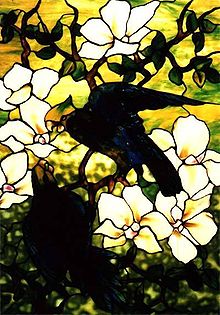Louis Comfort Tiffany
Louis Comfort Tiffany (born February 18, 1848 in New York ; † January 17, 1933 there ) was an American entrepreneur, painter and glass artist. He is considered one of the most important American representatives of Art Nouveau .
Life
At the age of 14, Tiffany was enrolled at the Eagleswood Military Academy in Perth Amboy, NJ, where he acquired the basics of his artistic training over the next three years because the landscape painter George Inness lived in Eagleswood from 1863 to 1867. His desire to study painting manifested itself in 1866 when he exhibited his pictures in the National Academy of Design in 1867 after a trip that had taken him via England, Ireland, France and Italy to Sicily . On his second trip to Europe in 1868, he visited the studio of Léon Belly , who painted oriental landscapes. Tiffany then traveled to North Africa with Samuel Colman in the spring of 1870 , visiting Egypt, Tunisia, Algeria and Morocco. This trip also took him to Spain. On his return he received the artistic recognition he had hoped for when he was accepted as a member of the National Academy of Design.
Tiffany was particularly successful with its jewelry creations and the production of iridescent glasses . In 1870, Tiffany in Egypt is said to have been inspired by glasses from the tombs of the pharaohs for his famous chandelier decor. He also took up the enthusiasm for Japan of many aesthetes at the time and created designs that corresponded to this taste. He made his first experiments with glass in 1876 when he was working with opal glass at the Louis Heidt Glass Factory in New York .
In 1885, Tiffany founded the “Tiffany Art Glass Company” in New York, which he renamed “Tiffany Glass and Decorating Company” in 1892, a furniture store for which he worked as a painter, craftsman and glass artist. In 1893 he also founded the "Stourbridge Glass Company" in Long Island , which became known as Tiffany Furnaces from 1902 and whose operations were discontinued in 1924. Among other things, Tiffany renovated some rooms in the White House in 1882 . The "Tiffany Favrile Glasses" process was patented in 1894. In the same year, Tiffany established a collaboration with the art dealer Siegfried Bing in Paris.
With their playful floral motifs, Tiffany's glass creations are among the most beautiful Art Nouveau glasses. Tiffany also designed flat glass ( mosaics and windows ), e.g. B. for the Tiffany Chapel in New York Cathedral. Tiffany lights , whose shades are largely made of colored pieces of glass that were previously enclosed in copper foil and then soldered together, were particularly valued . This technique of connecting pieces of glass (Tiffany glass art technique) made Tiffany and his glass creations world famous. His lamps were made with bronze elements from Duffner and Kimberly Co. in New York.
In 1902 he also owned Tiffany & Co. , his father Charles Lewis Tiffany's New York jewelry store . After Tiffany's death, his operations were completely sold until 1928 and produced Tiffany-style glass until 1931, but without the use of his signature.
His daughter Dorothy Tiffany Burlingham first moved to Vienna to have her son treated by Anna Freud and then went to London with the Freud family, as they had a particularly close friendship with Anna Freud.
With the Frederick Ayer Mansion in Boston, there is only one building left in the world that has Tiffany's works of art, both on the outside and inside, largely in their original state.
Labelling
The labels "Louis C. Tiffany-Favrile" , "TGC" (Tiffany Glass Company) or " Louis C. Tiffany" + serial number are used to identify the glasses . The letters A – N in front of the serial number mean that the item was made between 1896 and 1900, the letters P – Z that it was made between 1901 and 1905. If the letters A – N come after the serial number, the items come from the years 1906 to 1912, the letters P – Z from the years 1913 to 1920. Objects marked with the letter O are custom-made items.
See also
Individual evidence
- ↑ Alice Cooney Frelinghuysen: Louis Comfort Tiffany at the Metropolitan Museum of Art ISBN 978-0-3000-8559-4
- ↑ a b c d e f Ildikó Kálosi, Diána Radványi: Tiffany and Gallé - Art Nouveau Glass . Ed .: Gabriella Balla, translated by Alan Campbell. Hungarian Museum of Applied Arts , Budapest 2007, ISBN 978-963-9738-03-4 , p. 45, 71, 137 .
Web links
- Beyars Lexicon
- Literature by and about Louis Comfort Tiffany in the catalog of the German National Library
- Literature by and about Louis Comfort Tiffany in the WorldCat bibliographic database
- Louis Tiffany biography
- two paintings by Louis Comfort Tiffany in the Brooklyn Museum
- Mr. Louis C. Tiffany's Hall Publisher: The Decorator and Furnisher. December 1, 1894
- Louis C. Tiffany: Art: The Quest of Beauty. Publisher: The Lotus Magazine (March 1, 1916)
- Louis C. Tiffany: Color and Its Kinship to Sound Publisher: The Art World (May 1, 1917)
- Tiffany favrile glass, Tiffany windows, Tiffany mosaics, Tiffany monuments, Tiffany granite. Author: Tiffany Studios (New York, NY) 1922
- Louis Comfort Tiffany in the Metropolitan Museum
- Tiffany in the Charles Hosmer Morse Museum of American Art
- Tiffany Scholar resource
- Tiffany website
| personal data | |
|---|---|
| SURNAME | Tiffany, Louis Comfort |
| BRIEF DESCRIPTION | American painter and glass artist |
| DATE OF BIRTH | February 18, 1848 |
| PLACE OF BIRTH | New York City |
| DATE OF DEATH | January 17, 1933 |
| Place of death | New York City |






